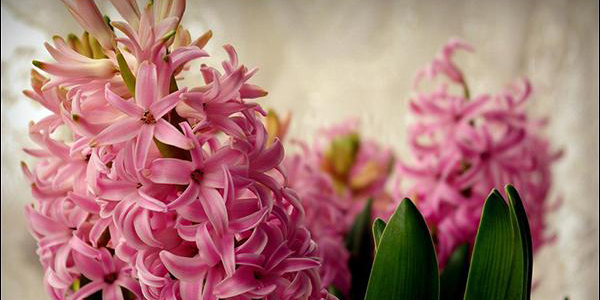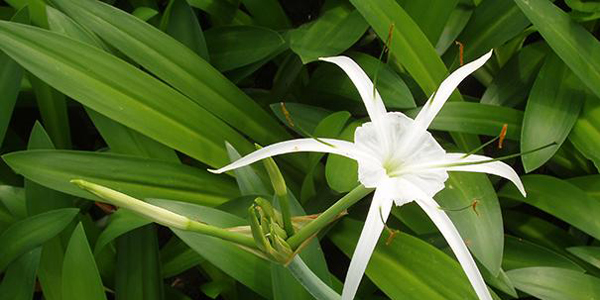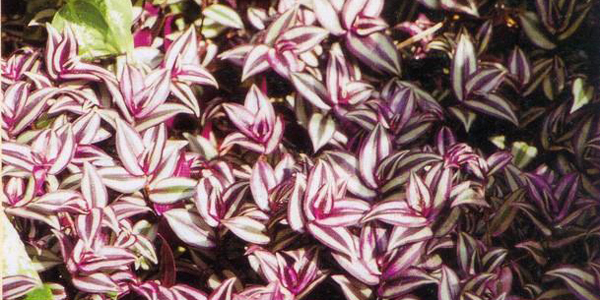How to propagate hyacinth and how to deal with it after flowering
Most of the time, the hyacinth planted by people is dried up and discarded after blooming once, without thinking about blooming again the next year. So let's take a look at how hyacinths reproduce and how to deal with them after they bloom.

How does hyacinth breed:
The reproduction methods of hyacinth can be divided into bulblet reproduction and seed reproduction, mainly bulblet reproduction. In June every year, the bulbs are dug out after the leaves are yellow, removed the soil, dried and stored in a cool and ventilated place, or can be stored in the refrigerator, and then replanted in autumn. The bulbs can blossom in the early spring of next year, and the bulbs need to be cultivated for 3 years to bloom.
1. The method of dividing balls and propagating hyacinths is as follows:
① dug up the bulbs during the dormant season and spread them evenly indoors to dry.
② selected a large bulb, cut the base into a concave base, and then cut into the center of the bulb as a cross, cutting directly from the base of the bulb to the terminal bud, reaching to the middle of it.
After the ③ was cut, the juice secreted by the incision was slightly dried, then disinfected with 0.1% mercury water or sodium hypochlorite solution and dried for 1 to 2 hours.
④ was shallowly buried in the soil, and by the end of the following summer, many bulbs could grow around the bulb notch, which would be dug up a year later, dried and planted separately.
Such as indoor, planted in a shallow basin, spread into a layer, room temperature kept at about 21 ℃ to produce calli, when the bulb expanded, the temperature gradually rose to 30 ℃, relative humidity about 85%, about 3 months can grow many small bulbs, can be dug out, dried, separated and planted. For the cultivated balls, the big balls can blossom in the early spring of the second year, and the small balls need to be cultivated for 2-3 years before they can blossom.
2. The method of seed propagation of hyacinth:
This technique is often used in the cultivation of new varieties, mainly pay attention to timely seed collection, early harvest, seed development is not mature; too late seed is easy to scatter, it is necessary to sow with picking and cultivate for 4-5 years before flowering. Sowed into the culture soil in the cold bed in autumn, covered with 1 cm of soil, and germinated at the end of January and the beginning of February of the following year. The bulbs cultured from seedlings blossom after 4-5 years. Under general conditions, the germination ability of seeds can be maintained for 3 years. # p# subtitle # e #
What to do after the hyacinth blossoms:
Because many people do not pay attention to breeding methods, they are usually discarded after blooming once. In fact, they can blossom every year, but the inflorescence is smaller every year, but it is no longer degraded to a certain extent, and even small balls can blossom smoothly.
There are two main reasons for the degradation of hyacinth. One is that the bulb expansion of this kind of plant is the most important period after flowering. The climate of the place of origin is mild, and the weather is obviously hot after June, and the humidity is not low. In this way, the flowers will grow at a suitable temperature of 2-3 months after fade. The climate in China is very hot in early May, and it is relatively dry and hot, which promotes the early dormancy of plants and fails to expand fully. This is the main cause of degradation.
Do not throw away the hyacinth after flowering, replenish the fertilizer in time after flowering, pay attention to the leaf center can not touch water, put it in a cool place after May, delay the process of leaves from green to yellow as far as possible, can slow down the degree of degradation or even non-degradation. Even if degraded, different colors of hyacinth planted together also have a good ornamental effect.
The above is the introduction of hyacinth breeding methods and how to deal with hyacinth after flowering. If you want hyacinth at home to blossom year after year, you should pay attention to the supply of water and fertilizer after flowering to ensure the normal growth of hyacinth and prevent its degradation.
How to deal with potted hyacinth after flowering? How to blossom after hyacinth blossoms
More and more people like to plant potted hyacinth, so do you know what to do after potted hyacinth blossoms? Next, the editor will introduce the treatment methods of potted hyacinth after flowering for you in detail to help you better plant potted hyacinth.
Treatment methods of potted hyacinth after flowering:
The leaves of potted hyacinth will wither slowly after flowering. The withered leaves should be cut off, the bulbs should be dug out and placed in a cool and dry place. When it is hot in mid-July, it can be kept in the refrigerator (keep it for 15 ℃) to prevent decay. Take it out at the end of September, plant it in a basin containing ordinary culture soil, and put a few grains of compound fertilizer at the bottom of the basin. Then put it on the balcony and make it pass through natural low temperature for at least 5-7 weeks, keeping the basin soil moist during this period. In the 30-40 days from the Spring Festival, ice into the indoor light is sufficient, often watering, so that the basin soil is moist without stagnant water. The best room temperature is about 20 ℃. It should be watered properly when the temperature is high, and try to increase the temperature when it is low, so that it can blossom again during the Spring Festival. A flowering bulb can be cultured like this for about 2-3 years.
If the water-raised hyacinth, first of all, when the hyacinth blossoms and withered in the spring, you only need to continue the water culture, this process will probably continue until the beginning of June, when you will find that the leaves of the hyacinth are already a little withered and yellow. This shows that hyacinth has reached its summer dormancy.
Then, all you need to do is trim off the leaves and roots of the hyacinth, leaving only the bulbs. After the completion of this step, put the bulb in a dark place to dry, must not be exposed to the sun. If you find that the hyacinth bulbs have dried after two or three days, just wrap them in newspapers and put them in the freezer. The bulbs are put in the freezer so that the bulbs will not rot due to high temperature or exposure. Bulbs begin to hibernate in the freezer, waiting for the real winter to come.
The last and most important step is to rebreed it. Around November, the weather is getting cooler, and it's time to take the hyacinth out of the freezer. Put the extracted bulb on the suitable bottleneck, and then add water. When adding water, note that the water needs to be added to the distance from the bulb 1CM, more or less will affect the re-rooting. After adding the water, put it in a completely dark place with a temperature of about 5 degrees Celsius. After 25 days, you will find a miracle, and the hyacinth has roots and vitality again. Then, just follow the usual breeding methods, and your hyacinth will bloom again.
How to deal with hyacinth after flowering the correct treatment method after flowering
Hyacinth blossoms several times a year, which is unknown to many friends. In fact, hyacinth only blossoms once a year, and most friends throw it away after a year of breeding. In fact, it is not necessary. As long as the effect of compound flowers is handled properly, how to deal with hyacinths after flowering? Let's get to know each other.
Post-flowering treatment of Hyacinth in Water Culture
1. Continue aquaculture: hyacinths after blooming continue to be hydroponized until the temperature rises gradually in early June, the leaves of hyacinths will wither and yellow and enter the summer dormancy period.
2. Cut off the leaves: cut off all the withered and yellow leaves of hyacinth in summer dormancy, and cut off all the roots.
3. Refrigerate hyacinth: put the bulb in a cool and ventilated place to dry for 1 to 2 days (never dry). After drying thoroughly, wrap the bulbs in a newspaper and put them in a can and put them in the freezer (not the freezer).
4. Temperature requirements: the temperature should not exceed 10 degrees during the summer, otherwise the bulbs are perishable.
5. Re-farming: when the temperature gradually turns cool into late autumn in November, take out the hyacinth bulbs that have been preserved for a summer, place them on the mouth of the bottle in a proper container, add water to about 1CM from the bottom of the bulbs, and then place them in a completely dark and cool place for 5 ℃ to promote rooting. The root system will sprout after about 25 days, and when the root system grows to 2CM, it can be raised according to the normal maintenance method of hyacinth until it blossoms. In general, in this cycle, hyacinths can be kept for about 3 years, and the original bulbs will basically no longer blossom in the 4th year.
Post-flowering treatment of hyacinth by soil culture and water culture
1. Keep the bulb: after the flowers of hyacinth are faded. Cut off all the leaves, stems, etc., and keep the bulbs. Then bury the bulbs in the sand and wait for the summer dormancy to come.
2. Re-breeding: around July 20, dig it out, put it in the freezer, keep it at 4 ℃, promote germination at low temperature, wait for the growth point to sprout, continue to bury it in the sand, water it once every 15 days, and wait for the pot cultivation in December, the management is very extensive, and there is no special technology.
This is how to deal with the hyacinth shared by Xiaoqi after flowering. If you don't want to buy hyacinth again in the coming year, you might as well learn it.
- Prev

What are the methods of raising water ghost plantains?
The water ghost banana plant is bright green and sturdy, and its impression is long and graceful. It is a good flower and foliage plant. So, how to raise water ghost bananas? Today, the editor will introduce the culture method of Shuighui banana. How to raise water ghost bananas: to know how to raise water ghost bananas, we must first understand the growth habits of water ghost bananas.
- Next

Can hanging bamboo plum be raised in water and culture methods?
Hanging bamboo plum branches and leaves crawling, leaves purple, green, silver alternately, can be placed on the top of the cabinet, or for hanging basin appreciation, evil spirit is good-looking. So, can hanging bamboo plum be raised in water? Today, the editor will introduce the culture method of hanging bamboo plum in water culture. Can hanging bamboo plum be raised by water? so can hanging bamboo plum
Related
- Fuxing push coffee new agricultural production and marketing class: lack of small-scale processing plants
- Jujube rice field leisure farm deep ploughing Yilan for five years to create a space for organic food and play
- Nongyu Farm-A trial of organic papaya for brave women with advanced technology
- Four points for attention in the prevention and control of diseases and insect pests of edible fungi
- How to add nutrient solution to Edible Fungi
- Is there any good way to control edible fungus mites?
- Open Inoculation Technology of Edible Fungi
- Is there any clever way to use fertilizer for edible fungus in winter?
- What agents are used to kill the pathogens of edible fungi in the mushroom shed?
- Rapid drying of Edible Fungi

